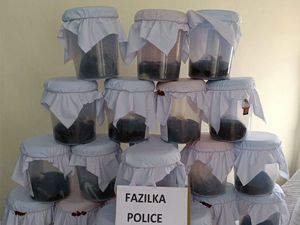
Major Virender Singh Ruhil
Know your heroes: Virender singh Ruhil
Col Dilbag Singh Dabas (Retd)
Major Virender Singh Ruhil is a second generation soldier. His father Captain Chandan Singh from 3 Grenadiers was World War-II veteran, who took part in the first India-Pakistan war in Kashmir in 1947-48, as also in 1962 India-China conflict. Virender was born on May 19, 1940, at Dehkora village in Rohtak district of the then undivided Punjab.
The account of his bravery reads...
“On December 5/6 night in 1971, during the 6th Bihar Battalion's attack on Mymensingh, Major Virender Singh Ruhil, although a Battery Commander formed part of the leading platoon as artillery Forward Observation Officer (FOO). By first light on December 6, 1971, the 6 Bihar had captured Mymensingh, but while it was re-organising the defenses on the captured objective, the enemy launched a determined counter-attack supported by machine guns and mortars. Major Virender Singh Ruhil, with total disregard to personal safety, went ahead of the captured objective and brought down accurate artillery fire on the attackers. Although fully exposed to the enemy fire, he kept engaging the enemy till the counter-attack by the enemy petered out and the enemy withdrew. Though affiliated to the 6 Bihar Battalion for providing artillery support, Major Ruhil volunteered to act as artillery FOO for the 13 Guards battalion's attack on Mirpur on December 15/16 night. When the attack was held up due to intense fire from the enemy, Major Virender Ruhil, yet again, fully exposed to the enemy fire, crawled forward to an advantageous position, from where he could observe the bunkers, where from the fire was coming and brought down devastating artillery fire on the enemy machine gun bunkers. After half an hour of artillery bombardment in rapid rate of fire by Major Ruhil, the 13 Guards resumed its attack and captured the objective with minimum casualties to own troops. Major Ruhil thus lived up to the motto of the gunners "Sarvatra Izzat-o-Iqbal" in letter and spirit. For his professional competence, aggressive spirit and determination in the face of the enemy, Major Virender Singh Ruhil was awarded the Vir Chakra.”
Dehkora is now in Jhajjar district of Haryana. He had his early education at Mission High School, Nasirabad, where his father was posted. After matriculation from King George's School, Ajmer, Virender qualified for and joined the National Defence Academy (NDA) in 1956. After three years at NDA and one year at the Indian Military Academy, Dehradun, Virender was commissioned into the Regiment of Artillery on December 18, 1960. Virender had opted for the 3rd Grenadiers as parental claim, but could not get his preferred battalion due to service constraints. Instead, he was allotted the Regiment of Artillery.
At the time of 1971 India-Pakistan war, Virender, now a Major, was serving as a Battery Commander with 85 Light Regiment in the Eastern Theatre.
By middle of 1971, it was evident that the Indian Army was sure to move into East Pakistan once the monsoon came to an end. Pakistan army was not oblivious to the Indian mood and over time had fortified its strategic towns and held them in strength. Besides Dhaka, the other prominent towns well-defended were Comilla and Mymensingh in the east and Jessore and Khulna in the west. Despite repeated onslaughts by the Indian infantry, Mymensingh held on till 6 Bihar Battalion, during its attack on December 5/6 night in 1971, ran through the town and paved the way for advance on to Dhaka.
The next strongly held bound was Mirpur, North West of Dhaka. Pakistan army guarding Mirpur also could not withstand the lightening attack by the 13 Guards battalion on December 15/16 night in 1971 and withdrew to Dhaka. In both these successful battles, artillery support played the most significant role. In both these battles, Major Virender Singh Ruhil of 85 Light Regiment was not just the Battery Commander, but acted as artillery Forward Observation Officer (FOO) who, at grave risk in the face of the enemy, brought down accurate and effective artillery fire on the enemy, degrading its will to fight.
During war, the Artillery Battery Commander moves with the affiliated infantry battalion and acts as an advisor to the battalion commander. He makes the fire plan to the best advantage of the attacking troops based on the availability of the fire units. For execution of the fire plan and also taking impromptu artillery shoots during the attack, FOO of the battery, young subalterns or captions execute the fire plan by being with the forward troops leading the attack.
It is very rare that during assault, the battery commander himself acts as the FOO. Major Virender Singh Ruhil, the Battery Commander with 85 Light Regiment, volunteered to act as FOO during the assault not just once, but in two crucial attacks. Of course, on both occasions the targets near the North Eastern border of then East Pakistan were of immense strategic importance to India for its hot pursuit on to Dhaka.
Major Virender Singh Ruhil, Vr C, a qualified instructor in gunnery, was nominated to attend the prestigious staff course at Defence Services Staff College, Wellington, Nilgiri Hills, Madras (now Tamil Nadu) after the 1971 War, also referred to as operation 'Cactus Lily'. In 1977, he picked up the rank of Lieutenant Colonel (Lt Col) and commanded the 216 Medium Regiment for two years. Lt Col Virender Singh Ruhil, Vr C, rose to the rank of a Brigadier and commanded the 11 Artillery Brigade before he retired from the Army in 1994.
Brigadier Virender Singh Ruhil, Vr C, a veteran of 1971 India-Pakistan War, after retirement, has settled in Gurgaon and keeps himself occupied assisting the ex-servicemen in whatever manner he can.
About Kirti Chakra
- The Vir Chakra was established by the President of India on January 26, 1950, with the awards effective from Aug 15, 1947
- Awarded for the gallantry of a high order in the face of the enemy on ground, at sea or in the air. The medal may also be awarded posthumously.
- Award of the decoration carries with it the right to use Vr C as a post-nominal abbreviation (different from Victoria Cross, which is VC)
- The provision was made for the award of a Bar for a second (or subsequent) award of Vir Chakra.
- Among 10 known awards of Bar to Vir Chakra, two brave-hearts namely Wing Commander Purshotam Lal Dhawan (1948 and 1962) and Wing Commander Vinod Neb (1965 and 1971) have been nurtured by the Haryana soil
(The writer is a veteran Gunner, 6 Field Regiment)
Join Whatsapp Channel of The Tribune for latest updates.



























